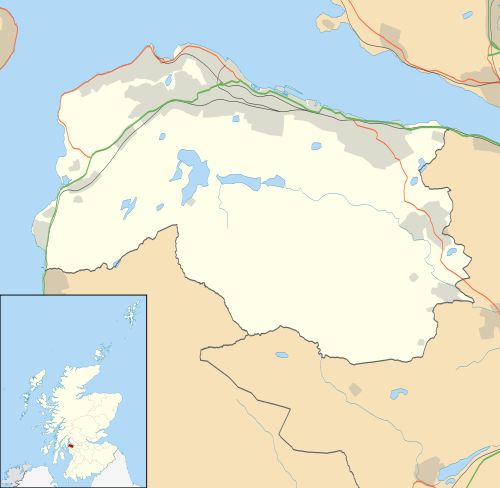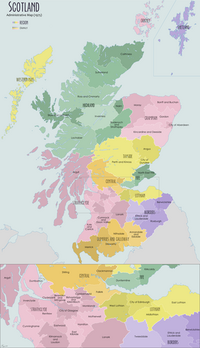Inverclyde
Inverclyde
Inerclyde Inbhir Chluaidh | |
|---|---|
 | |
| Coordinates: 55°54′N 4°45′W / 55.900°N 4.750°W | |
| Sovereign state | United Kingdom |
| Country | Scotland |
| Lieutenancy area | Renfrewshire |
| Admin HQ | Greenock |
| Government | |
| • Body | Inverclyde Council |
| • Control | Labour minority (council NOC) |
| • MPs | |
| • MSPs | |
| Area | |
| • Total | 61.9 sq mi (160.4 km2) |
| • Rank | Ranked 29th |
| Population (2021) | |
| • Total | 76,700 |
| • Rank | Ranked 28th |
| • Density | 1,200/sq mi (480/km2) |
| ONS code | S12000018 |
| ISO 3166 code | GB-IVC |
| Website | www |
Inverclyde (Scots: Inerclyde, Scottish Gaelic: Inbhir Chluaidh, pronounced [iɲiɾʲˈxl̪ˠuəj], "mouth of the Clyde") is one of 32 council areas used for local government in Scotland. Together with the East Renfrewshire and Renfrewshire council areas, Inverclyde forms part of the historic county of Renfrewshire, which currently exists as a registration county and lieutenancy area. Inverclyde is located in the west central Lowlands. It borders the North Ayrshire and Renfrewshire council areas, and is otherwise surrounded by the Firth of Clyde.
Inverclyde was formerly one of nineteen districts within Strathclyde Region, from 1975 until 1996. Prior to 1975, Inverclyde was governed as part of the local government county of Renfrewshire, comprising the burghs of Greenock, Port Glasgow and Gourock, and the former fifth district of the county. Its landward area is bordered by the Kelly, North and South Routen burns to the southwest (separating Wemyss Bay and Skelmorlie, North Ayrshire), part of the River Gryfe and the Finlaystone Burn to the south-east.
It is one of the smallest in terms of area (29th) and population (28th) out of the 32 Scottish unitary authorities. Along with the council areas clustered around Glasgow it is considered part of Greater Glasgow in some definitions,[1] although it is physically separated from the city area by open countryside and does not share a border with the city.
The name derives from the extinct barony of Inverclyde (1897) conferred upon Sir John Burns of Wemyss Bay and his heirs.
Council[edit]
History[edit]
Inverclyde was created as a district in 1975 under the Local Government (Scotland) Act 1973, which established a two-tier structure of local government across mainland Scotland comprising upper-tier regions and lower-tier districts. Inverclyde was one of nineteen districts created within the region of Strathclyde. The district covered the area of four former districts from the historic county of Renfrewshire, all of which were abolished at the same time:[2][3]
- Greenock Burgh
- Gourock Burgh
- Port Glasgow Burgh
- Fifth District, being the landward (outside a burgh) parts of the parishes of Greenock, Inverkip, Port Glasgow, and Kilmacolm.
The new district was named Inverclyde, meaning "mouth of the River Clyde", a name which had been coined in 1897 for the title of Baron Inverclyde which was conferred upon John Burns of Castle Wemyss, a large house at Wemyss Bay. The remaining parts of Renfrewshire were divided between the Eastwood and Renfrew districts. The three districts together formed a single lieutenancy area.[4]
In 1996 the districts and regions were replaced with unitary council areas under the Local Government etc. (Scotland) Act 1994. In the debates leading up to that act, the government initially proposed replacing these three districts with two council areas: "West Renfrewshire", covering Inverclyde district and the western parts of Renfrew district, and "East Renfrewshire", covering Eastwood district and the eastern parts of Renfrew district.[5] The proposals were not supported locally, with Inverclyde successfully campaigning to be allowed to form its own council area. The new council areas came into effect on 1 April 1996.[6][7]
Settlements[edit]
Settlements by population:
| Settlement | Population (mid-2020 est.)[8] |
|---|---|
| Greenock |
41,280 |
| Port Glasgow |
14,200 |
| Gourock |
10,210 |
| Kilmacolm |
3,930 |
| Inverkip |
3,490 |
| Wemyss Bay |
2,390 |
| Quarrier's Village |
710 |
Communities[edit]
The area is divided into eleven community council areas, seven of which have community councils as at 2023 (being those with asterisks in the list below):[9]
- Gourock*
- Greenock Central
- Greenock East
- Greenock Southwest*
- Greenock West and Cardwell Bay*
- Holefarm and Cowdenknowes
- Inverkip and Wemyss Bay*
- Kilmacolm*
- Larkfield, Braeside and Branchton*
- Port Glasgow East
- Port Glasgow West*
Places of interest[edit]
- Ardgowan Estate
- The Bogal Stone
- Cappielow
- Castle Levan
- Clyde Muirshiel Regional Park
- Greenock Cut Visitor Centre[10]
- Custom House Quay and Museum[11]
- Duchal House
- Finlaystone House
- Gourock Outdoor Pool[12]
- Granny Kempock Stone
- Loch Thom
- Lunderston Bay[10]
- McLean Museum and Art Gallery[13]
- Newark Castle[14]
- Waterfront Leisure Complex[15]
National voting[edit]
In the 2014 independence referendum, the "No" vote won in Inverclyde by just 86 votes and a margin of 0.2%. By either measure, this was the narrowest result of any of the 32 council areas. In the 2016 EU Referendum, Inverclyde posted a "Remain" vote of almost 64%.
Education[edit]
Inverclyde has twenty primary schools serving all areas of its settlements. These are:
- Aileymill Primary School, Greenock (merger of Larkfield and Ravenscraig primaries)
- All Saints Primary School, Greenock (merger of St. Kenneth's and St. Lawrence's primaries)
- Ardgowan Primary School, Greenock
- Gourock Primary School, Gourock
- Inverkip Primary School, Inverkip
- Kilmacolm Primary School, Kilmacolm/Port Glasgow
- King's Oak Primary School, Greenock (merger of King's Glen and Oakfield primaries)
- Lady Alice Primary School, Greenock
- Moorfoot Primary School, Gourock
- Newark Primary School, Port Glasgow (merger of Boglestone, Clune Park, Highholm and Slaemuir primaries)
- St. Andrew's Primary School, Greenock (merger of Sacred Heart and St. Gabriel's primaries)
- St. Francis' Primary School, Port Glasgow
- St. John's Primary School, Port Glasgow
- St. Joseph's Primary School, Greenock
- St. Mary's Primary School, Greenock
- St. Michael's Primary School, Port Glasgow
- St. Ninian's Primary School, Gourock
- St. Patrick's Primary School, Greenock
- Wemyss Bay Primary School, Wemyss Bay
- Whinhill Primary School, Greenock (merger of Highlanders' Academy and Overton primaries)
These are connected to several Secondary schools which serve Inverclyde as follows:
- Clydeview Academy, serving the West End of Greenock and the town of Gourock
- Inverclyde Academy, serving South and East Greenock as well as the villages of Inverkip and Wemyss Bay
- Notre Dame High School, serving Greenock
- Port Glasgow High School, serving Port Glasgow and Kilmacolm
- St Columba's High School, Gourock/Greenock, serving Gourock, Inverkip and Wemyss Bay
- St. Stephen's High School, serving Port Glasgow, Kilmacolm and the East End of Greenock
- Craigmarloch School which is an Additional Support Needs school for pupils aged 4–18 based at the new Port Glasgow Community Campus after the merging of Glenburn and Lilybank schools.
Demography[edit]
The average life expectancy for Inverclyde male residents (2013–2015) is 75.4 years, to rank 28th out of the 32 areas in Scotland. The average Inverclyde female lives for 80.4 years, to rank 26th out 32.[16] There are large health disparities between settlements in Inverclyde with many health indicators being above the Scottish average in certain areas, whilst considerably below in others.[17]
In 2019, the Inverclyde Council Area was rated as the most deprived in Scotland by the Scottish Index of Multiple Deprivation (SIMD), with Greenock Town Centre the most deprived community. (The term "deprivation" refers not only to low income according to the BBC, but may also include "fewer resources and opportunities, for example in health and education".) After the announcement, Deputy leader Jim Clocherty said that he hoped that investment money would arrive soon, and that "no part of Scotland wants to be labelled as the 'most deprived'". A £3m investment was scheduled for Greenock Town Centre and there was also plan to create a new cruise visitor centre with other investment funds being expected.[18]
See also[edit]
References[edit]
- ^ "Glasgow and Clyde Valley Structure Plan Joint Committee". www.gcvcore.gov.uk. Archived from the original on 20 May 2007. Retrieved 13 January 2022.
- ^ "Local Government (Scotland) Act 1973", legislation.gov.uk, The National Archives, 1973 c. 65, retrieved 9 February 2023
- ^ "No. 14632". The Edinburgh Gazette. 7 March 1930. p. 258.
- ^ "The Lord-Lieutenants Order 1975", legislation.gov.uk, The National Archives, SI 1975/428, retrieved 9 February 2023
- ^ "Local Government (Scotland and Wales) Volume 233: debated on Monday 22 November 1993". Hansard. UK Parliament. Retrieved 6 February 2023.
- ^ "Local Government Etc (Scotland) Bill: Volume 235: debated on Monday 17 January 1994". Hansard. UK Parliament. Retrieved 10 February 2023.
- ^ "Local Government etc. (Scotland) Act 1994", legislation.gov.uk, The National Archives, 1994 c. 39, retrieved 6 February 2023
- ^ "Mid-2020 Population Estimates for Settlements and Localities in Scotland". National Records of Scotland. 31 March 2022. Retrieved 31 March 2022.
- ^ "Community Council Pages". Inverclyde Council. Retrieved 14 February 2023.
- ^ a b "Clyde Muirshiel – Scotland's Largest Regional Park". clydemuirshiel.co.uk.
- ^ [1] Archived 23 September 2006 at the Wayback Machine
- ^ "Online Member Services". www.inverclydeleisure.com. Archived from the original on 13 February 2006. Retrieved 1 September 2005.
- ^ "McLean Museum and Art Gallery - Inverclyde Council - Museum & Art Gallery". Archived from the original on 22 November 2005. Retrieved 1 September 2005.
- ^ "Historic Environment Scotland". www.historic-scotland.gov.uk.
- ^ "Online Member Services". www.inverclydeleisure.com.
- ^ "Life expectancy for areas within Scotland 2013–2015" (PDF). National records for Scotland. Retrieved 1 January 2017.
- ^ "Browser Health". Archived from the original on 4 April 2012. Retrieved 23 June 2011.
- ^ "Scotland's most and least deprived areas named". BBC News. 28 January 2020. Retrieved 28 January 2020.





